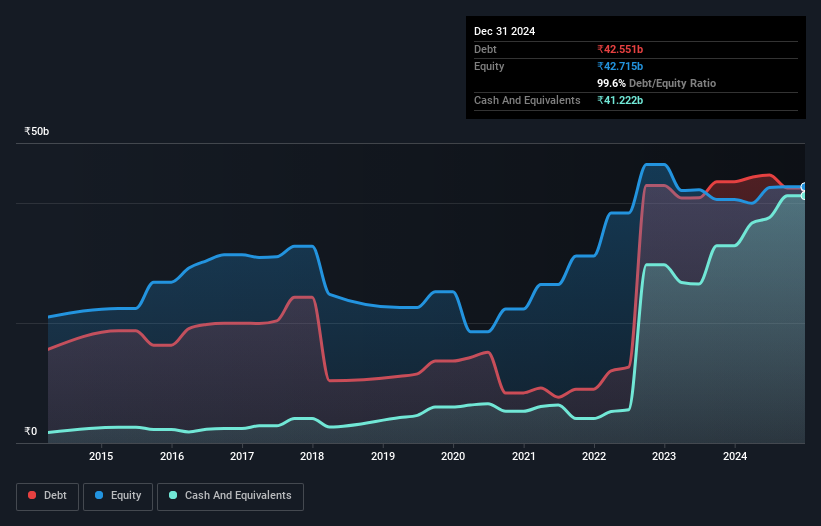Is Jindal Poly Films (NSE:JINDALPOLY) Using Too Much Debt?
Warren Buffett famously said, 'Volatility is far from synonymous with risk.' So it seems the smart money knows that debt - which is usually involved in bankruptcies - is a very important factor, when you assess how risky a company is. Importantly, Jindal Poly Films Limited (NSE:JINDALPOLY) does carry debt. But is this debt a concern to shareholders?
What Risk Does Debt Bring?
Debt assists a business until the business has trouble paying it off, either with new capital or with free cash flow. In the worst case scenario, a company can go bankrupt if it cannot pay its creditors. While that is not too common, we often do see indebted companies permanently diluting shareholders because lenders force them to raise capital at a distressed price. By replacing dilution, though, debt can be an extremely good tool for businesses that need capital to invest in growth at high rates of return. When we examine debt levels, we first consider both cash and debt levels, together.
Check out our latest analysis for Jindal Poly Films
How Much Debt Does Jindal Poly Films Carry?
The chart below, which you can click on for greater detail, shows that Jindal Poly Films had ₹42.6b in debt in September 2024; about the same as the year before. However, it does have ₹41.2b in cash offsetting this, leading to net debt of about ₹1.33b.

How Strong Is Jindal Poly Films' Balance Sheet?
Zooming in on the latest balance sheet data, we can see that Jindal Poly Films had liabilities of ₹20.1b due within 12 months and liabilities of ₹45.7b due beyond that. Offsetting this, it had ₹41.2b in cash and ₹14.0b in receivables that were due within 12 months. So its liabilities total ₹10.6b more than the combination of its cash and short-term receivables.
While this might seem like a lot, it is not so bad since Jindal Poly Films has a market capitalization of ₹31.2b, and so it could probably strengthen its balance sheet by raising capital if it needed to. But it's clear that we should definitely closely examine whether it can manage its debt without dilution.
In order to size up a company's debt relative to its earnings, we calculate its net debt divided by its earnings before interest, tax, depreciation, and amortization (EBITDA) and its earnings before interest and tax (EBIT) divided by its interest expense (its interest cover). This way, we consider both the absolute quantum of the debt, as well as the interest rates paid on it.
Jindal Poly Films has a very low debt to EBITDA ratio of 0.43 so it is strange to see weak interest coverage, with last year's EBIT being only 0.63 times the interest expense. So one way or the other, it's clear the debt levels are not trivial. Notably, Jindal Poly Films made a loss at the EBIT level, last year, but improved that to positive EBIT of ₹788m in the last twelve months. There's no doubt that we learn most about debt from the balance sheet. But you can't view debt in total isolation; since Jindal Poly Films will need earnings to service that debt. So when considering debt, it's definitely worth looking at the earnings trend. Click here for an interactive snapshot.
Finally, a business needs free cash flow to pay off debt; accounting profits just don't cut it. So it's worth checking how much of the earnings before interest and tax (EBIT) is backed by free cash flow. During the last year, Jindal Poly Films produced sturdy free cash flow equating to 55% of its EBIT, about what we'd expect. This cold hard cash means it can reduce its debt when it wants to.
Our View
Jindal Poly Films's interest cover was a real negative on this analysis, although the other factors we considered were considerably better. In particular, we are dazzled with its net debt to EBITDA. When we consider all the factors mentioned above, we do feel a bit cautious about Jindal Poly Films's use of debt. While we appreciate debt can enhance returns on equity, we'd suggest that shareholders keep close watch on its debt levels, lest they increase. There's no doubt that we learn most about debt from the balance sheet. But ultimately, every company can contain risks that exist outside of the balance sheet. For instance, we've identified 1 warning sign for Jindal Poly Films that you should be aware of.
If you're interested in investing in businesses that can grow profits without the burden of debt, then check out this free list of growing businesses that have net cash on the balance sheet.
New: Manage All Your Stock Portfolios in One Place
We've created the ultimate portfolio companion for stock investors, and it's free.
• Connect an unlimited number of Portfolios and see your total in one currency
• Be alerted to new Warning Signs or Risks via email or mobile
• Track the Fair Value of your stocks
Have feedback on this article? Concerned about the content? Get in touch with us directly. Alternatively, email editorial-team (at) simplywallst.com.
This article by Simply Wall St is general in nature. We provide commentary based on historical data and analyst forecasts only using an unbiased methodology and our articles are not intended to be financial advice. It does not constitute a recommendation to buy or sell any stock, and does not take account of your objectives, or your financial situation. We aim to bring you long-term focused analysis driven by fundamental data. Note that our analysis may not factor in the latest price-sensitive company announcements or qualitative material. Simply Wall St has no position in any stocks mentioned.
About NSEI:JINDALPOLY
Jindal Poly Films
Manufactures and sells biaxially oriented polyethylene terephthalate (BOPET) films, and BOPP films in India and internationally.
Average dividend payer with mediocre balance sheet.
Similar Companies
Market Insights
Community Narratives



